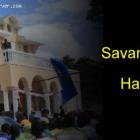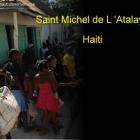ADVERTISEMENT
Environment - Haiti Observer Blog
Environment, Haiti Observer Blog. Read the following articles about Environment
Haiti food shortage made worst by drought caused by El Nino
It has been observed that around 3.6 million people in Haiti are currently struggling to feed themselves. According to the World Food bank, this has been caused by three consecutive years of drought that have affected harvest and raised food prices in Haiti.The water shortage is caused by a weather phenomenon called El Nino. According to observers, the current El Nino has caused widespread crop losses in several countries.
What do you think?
Haitian Kreyol
Ayiti mank
Pwoblèm manje ak grangou an Ayiti vini pi mal pa sechrès ki te koze pa El Niño
Haiti South Coast Invaded by Sargassum or Seaweed Algae
In the past one year, Sargassum, a type of brown invasive alga that got its name from its huge floating masses in the Sargasso Sea, is choking off the Caribbean's beaches. Its massive tide is affecting some communities in Haiti, as well, especially at St Jean du South, St Louis du South, Côtes de fer, Les Cayes, Jacmel, Cayes Jacmel, and Marigot. Surrounding waters of these areas are exposed to the risks of invasion and pollution of this brown, dead seaweed. Thick piles of Sargassum release hydrogen sulfide gas, which has an odor similar to rotten eggs. If this hazardous gas is inhaled over a longer period, it may cause headache, difficulty in breathing, vomiting, irritation of the eyes, throat, ears, etc. Some countries in the Caribbean like the Dominican Republic in the north, Mexico's Caribbean resorts to the west and Barbados in the east have initiated emergency money to fund to clear the stinking mounds of Sargassum blocking the beaches (in some cases upto 10 ft high) and the moored boats. If no immediate action is taken, it would be a definite cause of coastal pollution, losses in fishing and tourist revenue.
Sean Penn to make Haiti a model of Forestation with "Here come the Trees"
As you may know, there is currently a U.N. climate conference taking place in Paris, which runs through Dec. 11. It is one of the most important events of our time, involving leaders of some of the most powerful nations in the world. The objective of the conference is to achieve a legally binding and universal agreement on climate, from all the nations of the world.
Of the many countries at risk from the effects of climate change, small island such as Haiti is considered to be among the most vulnerable to sea level rise due to its high population densities, fragile ecosystems, overstressed water resources and others.
Haiti Climate Initiative with Sean Penn & French Officials
Around the globe, seasons are shifting, temperatures are climbing and sea levels are rising. Rising temperatures due to deforestation and excessive emission of Carbon are responsible for changing patterns of rain and melting of snows, especially in the Polar Regions. Rising seas threaten to inundate low-lying areas and islands, threaten dense coastal populations. Climate change is undoubtedly the greatest humanitarian crisis of our time. By 2050, according to the United Nations, more than 130 port cities and habitats around the world would be at risk from severe storm-surge flooding, damage from high storm winds, rising and warming global seas and local land subsidence.
France Embarks In Reforestation Project in Haiti
On Monday, September, 28, 2015, on the sidelines of the 70th General Assembly of the United Nations, the Haitian Defense and Foreign Affairs Minister, Minister of Environment, have signed a protocol with the French Minister of Ecology and other international actors for the execution of an important project of reforestation in Haiti.
After decades of work and millions of dollars invested by the international community, Haiti remains one of the most environmentally degraded countries on earth. With 98% of Haiti's forests already gone, a recent UN report estimates that about 30% of the nation's remaining trees are being destroyed each year. The majority of the Haitian population uses charcoal as their primary cooking fuel. Ségolène Royal, the French Minister of Ecology, during the ceremony, in the presence of French President Francois Hollande has said that the signing of the agreement came at a time when Haiti has suffered multiple natural hazards. As per the agreement, France will provide necessary expertise and framework through its nodal offices.
Haitian marine biologist received Goldman Environmental Foundation prize
Haitian Marine Biologist receives Environmental Protection Prize for Three Bays National Park
Haitian Jean Wiener, a marine biologist and teacher, has been given a $175,000 prize from the Goldman Environmental Foundation (GEF) for creating Three Bays National Park along the northern coast of Haiti. As the first marine protected area in Haiti, it will stop over-fishing of the coastal bays of Limonade, Caracol, and Fort Liberté. The park, in existence since 2014, includes a very large mangrove area, sizeable barrier reef, and crucial-to-the-environment sea grass beds.
Wiener, one of six prize winners, was acknowledged by the Goldman Foundation for prevailing over Haiti's poor-nation status and political upheavals to make Three Bays National Park a reality. The park encloses 30,000 square miles that extends from Cap-Haitien to the Dominican Republic border. He has also created the Marine Biodiversity Protection Foundation (FoProBiM) that targets coastal and marine areas for preservation. The U.N. and the U.S. Agency for International Development are funding partners for FoProBiM. FoProBiM engages community organizations to protect Three Bays marine resources from over-fishing, dying coral populations, and destroyed mangrove forests used to make charcoal for cooking.
Aerial seeding to curb environmental degradation and reforestation in Haiti
There have been concerns about the degradation of environmental resources in Haiti in recent years. In this respect, the President of Haiti, Michel Martelly, launched the campaign of aerial seeding in the south at the diplomatic lounge of the Toussaint Le'Overture International Airport. He was accompanied by Ache Steiner, Executive Director of the United Nations Environment Programme (UNEP),Jean Francois Thomas, the Minister of Environment,Representatives of UNESCO, Canada, Norway, and Inter-American Development Bank and Ms. Sandra Honour, Representative of the Secretary General of the United Nations, and the Director of the United Nations Development Programme (UNDP).
According to studies of experts in reforestation from Haiti and Cuba, aerial seeding is the only method that will stop the degradation of the environment in the mountainous areas which are inaccessible.
Haiti and Dominican Republic to jointly protect the environment
After the end of second level talk between Haiti and Dominican Republic in Jimani, the capital and the second largest city of the Independencia Province in the Dominican Republic, the two neighboring nations have agreed to protect the surrounding environment of Hispaniola Island which they jointly occupy. Though they share an island, they have remained worlds apart so far. This has played a direct role in adverse climate changes and its consequences in the area. The environment ministers from the two countries have agreed upon the urgent need to save the island's natural resources and environment. They will work under joint programs to manage cross-border natural resources and improve undivided watersheds. The two countries will deploy funds, manpower and work with the local communities in a collaborative way. Some international organizations will be engaged to find solution for environmental deterioration.
Pine forest (Foret des Pins) in Danger of Extinction
Haiti University Faculty of Law students are on a mission to save the Pine Forest of Haiti. A lush environment of stately trees and riotous wild flowers, it is in danger of becoming extinct through abandonment and misuse. The forest is a victim of deforestation, in which an ingrained habit, born of need, motivates rural residents to hew the wood to produce charcoal, so they may heat their homes and cook meals.
A non-government agency (NGA), USAID PAPH, has joined the students to produce a documentary film, which depicts them planting saplings as part of a rite to highlight their concerns about losing Pine Forest. During the program at the end of a three-day conference, attended by members of Parliament, they performed poetry readings and sang their country's national songs.
Etang Saumatre also known as Lac Azuei (Lake Azuei)
Haiti's version of the Dead Sea is the briny Etang Saumâtre, which translates in English to brackish pond. As Haiti's largest lake, it holds second place to the Dominican Republic's Lake Enriquillo as the second largest lake in Hispaniola. Known by some as Lake Azuéi, it is known by Haiti's neighbors as Lago del Fondo, and also by the Taíno name, Yainagua.
Found in what is described as the arid part of the Cul-de-Sac valley, the pond can be found less than 30 km east of the Haitian capital in the Ouest Department. At its northern side, it forms part of the border with the Dominican Republic.
Our objective is to share with you news and information about Haiti and the people of Haiti. Traditions, habits and the way we were or grew are alive in this site. We highly recommend that you Subscribe to our Newsletter and also share with us some of the things that are memorable and made us unique people.

 Haitians are a Proud People
Haitians are a Proud People  The Town of Savanette, Haiti
The Town of Savanette, Haiti  Something to think about
Something to think about  Haiti tech Summit
Haiti tech Summit  Saint Michel de L 'Atalaye
Saint Michel de L 'Atalaye